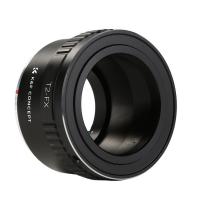How Much Can A Compound Microscope Magnify ?
A compound microscope can typically magnify an object up to 1000 times.
1、 Maximum magnification of a compound microscope
The maximum magnification of a compound microscope is determined by several factors, including the quality of the lenses, the numerical aperture, and the wavelength of light used. In general, compound microscopes can achieve magnifications ranging from 40x to 2000x or more.
The magnification of a compound microscope is calculated by multiplying the magnification of the objective lens (located near the specimen) with the magnification of the eyepiece (located near the viewer's eye). The objective lenses typically range from 4x to 100x, while the eyepieces commonly have magnifications of 10x or 20x. By combining different objective and eyepiece lenses, various magnifications can be achieved.
However, it is important to note that the maximum magnification does not necessarily equate to better image quality or resolution. At higher magnifications, the resolving power of the microscope becomes limited by the wavelength of light used. This is known as the diffraction limit. To overcome this limitation, specialized techniques such as oil immersion and higher numerical aperture objectives are employed.
Furthermore, the quality of the lenses and the overall design of the microscope play a crucial role in determining the maximum useful magnification. Factors such as lens aberrations, chromatic aberration, and image distortion can affect the clarity and accuracy of the magnified image.
In recent years, advancements in technology have led to the development of super-resolution microscopy techniques, such as stimulated emission depletion (STED) microscopy and structured illumination microscopy (SIM). These techniques can achieve resolutions beyond the diffraction limit, allowing for even higher magnifications and improved image quality.
In conclusion, the maximum magnification of a compound microscope typically ranges from 40x to 2000x or more, depending on various factors. However, achieving higher magnifications does not always guarantee better image quality, and other factors such as resolution and lens quality should also be considered.

2、 Factors influencing magnification in compound microscopes
A compound microscope is a powerful tool used in scientific research, education, and various other fields to observe and study microscopic objects. The magnification capability of a compound microscope is determined by several factors, including the design and quality of the microscope itself, as well as the lenses and objectives used.
The maximum magnification of a compound microscope is typically determined by the numerical aperture (NA) of the objective lens. The NA is a measure of the lens's ability to gather and focus light, and it is directly related to the resolving power of the microscope. The higher the NA, the greater the resolving power and potential magnification.
In general, compound microscopes can achieve magnifications ranging from 40x to 2000x or more. However, it is important to note that the practical limit of useful magnification is often lower than the maximum theoretical magnification. This is because as magnification increases, other factors such as image quality, depth of field, and light intensity can become limiting factors.
Factors influencing magnification in compound microscopes include the quality and design of the lenses, the numerical aperture of the objective lens, the quality of the specimen being observed, and the overall optical performance of the microscope. Additionally, the use of immersion oil and specialized techniques like phase contrast or differential interference contrast microscopy can enhance the resolving power and magnification capabilities of a compound microscope.
It is worth mentioning that recent advancements in technology have led to the development of super-resolution microscopy techniques, such as stimulated emission depletion (STED) microscopy and structured illumination microscopy (SIM). These techniques can achieve magnifications beyond the traditional limits of compound microscopes, allowing for the observation of structures at the nanoscale.
In conclusion, the maximum magnification of a compound microscope is influenced by various factors, including the design and quality of the microscope, the lenses and objectives used, and the techniques employed. While the practical limit of useful magnification is typically lower than the maximum theoretical magnification, advancements in microscopy techniques continue to push the boundaries of what can be observed and studied at the microscopic level.

3、 Optical limitations and practical magnification range in compound microscopes
The magnification capability of a compound microscope is determined by its optical limitations and practical range. Compound microscopes use a combination of objective and eyepiece lenses to achieve magnification. The objective lens is responsible for gathering light and forming the initial magnified image, while the eyepiece lens further magnifies this image for the viewer.
The maximum magnification of a compound microscope is limited by several factors. One of the main limitations is the resolving power of the microscope, which is determined by the wavelength of light used and the numerical aperture of the objective lens. The resolving power defines the microscope's ability to distinguish fine details in the specimen. As magnification increases, the resolving power decreases, limiting the clarity and sharpness of the image.
Another limitation is the depth of field, which refers to the thickness of the specimen that appears in focus at a given magnification. As magnification increases, the depth of field decreases, making it challenging to maintain focus on thicker specimens.
Practically, compound microscopes typically have a magnification range of 40x to 1000x. This range is achieved by combining different objective lenses with various magnification powers (e.g., 4x, 10x, 40x, 100x) and eyepiece lenses (usually 10x). The maximum useful magnification is often considered to be around 1000x, beyond which the image quality and resolution deteriorate significantly.
It is important to note that the maximum magnification alone does not determine the quality of a microscope. Factors such as lens quality, illumination, and specimen preparation also play crucial roles in achieving clear and detailed images. Additionally, advancements in technology and lens design may lead to improvements in the practical magnification range of compound microscopes in the future.

4、 Achieving higher magnification with additional lenses or techniques
A compound microscope is a powerful tool used in scientific research, education, and various other fields to observe and study microscopic objects. It consists of two or more lenses that work together to magnify the image of the specimen being observed. The magnification power of a compound microscope depends on the combination of lenses used and the numerical aperture of the lenses.
Typically, a compound microscope can magnify an object up to 1000 times its original size. This is achieved by combining the magnification of the objective lens (located near the specimen) and the eyepiece lens (located near the observer's eye). The objective lens provides the primary magnification, usually ranging from 4x to 100x, while the eyepiece lens further magnifies the image, typically by 10x.
To achieve higher magnification, additional lenses or techniques can be employed. One common technique is to use oil immersion, where a drop of oil with a refractive index similar to that of the glass slide and the lens is placed between the objective lens and the specimen. This reduces the loss of light and allows for higher magnification, often up to 100x or even 1000x.
Another technique is to use a higher numerical aperture (NA) lens. The NA is a measure of the lens's ability to gather light and resolve fine details. Lenses with higher NA can provide greater magnification and resolution. Advances in lens manufacturing technology have allowed for the development of lenses with higher NA, enabling compound microscopes to achieve even higher magnification.
It is important to note that while higher magnification can reveal finer details, it also comes with limitations. As magnification increases, the depth of field decreases, meaning that only a small portion of the specimen will be in focus at a time. Additionally, higher magnification may require more precise sample preparation and careful adjustment of the microscope's settings to obtain clear and accurate images.
In conclusion, a compound microscope can typically magnify objects up to 1000 times their original size. Achieving higher magnification can be accomplished through the use of additional lenses or techniques such as oil immersion and higher numerical aperture lenses. However, it is essential to consider the limitations and challenges associated with higher magnification, such as reduced depth of field and the need for meticulous sample preparation.






























